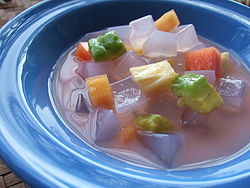- Nata de coco
-
Nata de coco is a chewy, translucent, jelly-like food product produced by the fermentation of coconut water, which gels through the production of microbial cellulose by Acetobacter xylinus. Nata de coco is most commonly sweetened as a candy or dessert, and can accompany many things including pickles, drinks, ice cream, puddings and fruit mixes. The product originates from the Philippines.
Contents
Etymology
Nata de coco comes from Spanish "cream of coconut". Cream in this sense means the fat from the coconut milk. The Spanish name is a result of Spain's colonization of the Philippines.
Nutrition
Nata de coco is highly regarded for its high dietary fibre, and its low fat and cholesterol content.
Strips of nata de coco are used in mass-produced bubble tea drinks as a healthier alternative to tapioca.[1]
Production
The primarily coconut water dessert is produced through a series of steps from:
- Extraction of coconut water
- Fermentation of the coconut water with bacterial cultures
- Separating and cutting the produced mat of nata de coco
- Cleaning and washing the acetic acid out of the nata de coco
- Cutting to packaging
Commercial nata de coco is made by small farms in the Philippines and Indonesia, especially in Jogjakarta province.
References
External links
Categories:- Desserts
- Fermented foods
- Philippine cuisine
- Coconuts
Wikimedia Foundation. 2010.

